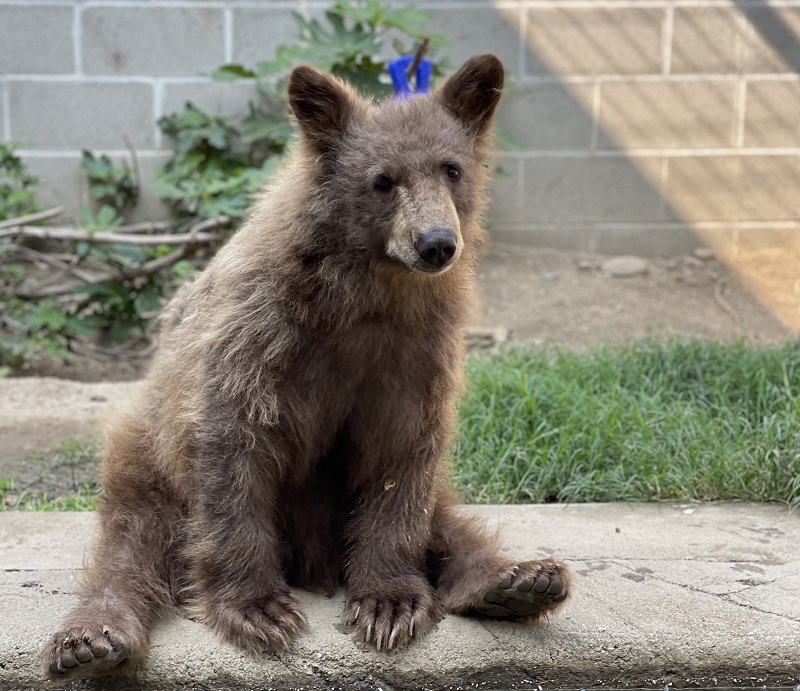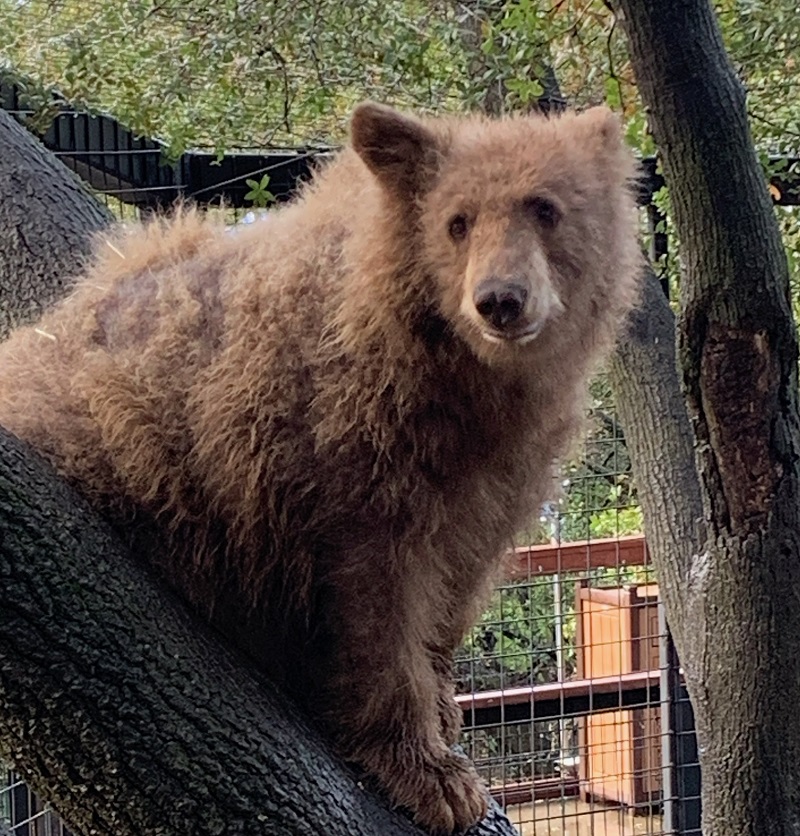Olive as a young bear in a fight for her life received intensive veterinary care from CDFW wildlife veterinarians to alleviate a skin condition that left her mostly hairless and unable to return to the wild. CDFW photo.
It was something of a soft launch in the spring of 2021 when the California Department of Fish and Wildlife (CDFW) placed a young, orphaned, female black bear with a skin condition with the Folsom City Zoo Sanctuary in Sacramento County.
The zoo had lost its popular 25-year-old black bear, “Marty,” to old age and had space to accept another bear. Currently, the zoo also has another black bear resident, “Henry,” a massive, 647-pound male that also arrived from CDFW as an orphan in 2003.
The small female bear with a chronic and unsightly skin condition that caused her to lose most of her fur was quietly welcomed into the Folsom City Zoo Sanctuary without fanfare or public notice.
Not all wild bears, even young ones, transition well to life in captivity. Those arriving with chronic medical conditions can be especially problematic, requiring a disproportionate amount of veterinary attention and resources for zoos and other animal sanctuaries. As these entities typically operate as nonprofits, they are often dependent on outside fundraising to meet expenses and tend to be on very tight budgets.
The prognosis for the “hairless bear” was not optimistic when CDFW recovered the sick yearling from the west shore of Lake Tahoe in April of 2021. The bear was in very poor shape. Bears with such extensive medical problems often have underlying issues and almost never recover to the point where they can make it on their own in the wild, even with medical intervention.
After delivery to CDFW’s Wildlife Health Lab (WHL) in Rancho Cordova, wildlife veterinarians went to work right away. A full veterinary exam, blood work, X-rays and skin tests were completed. The bear had very thickened skin with crusts all over. Tests confirmed CDFW’s initial suspicions of a severe, chronic skin infection known as a Trychophyton fungal infection. Based on WHL’s previous experience with similar cases and consultations with veterinary specialists, a battery of intensive treatments commenced, including weekly clinical baths, a suite of antimicrobial drugs, a carefully constructed diet and heaters to help the hairless bear maintain body temperature during the cold nights.
WHL’s experience with similar bears has been that because of the long-term treatments required, the bears can become “habituated,” which means they lose their natural fear of humans and can associate humans with food. Physically, there’s also the potential for irreversible damage to the bear’s hair follicles as a result of the skin condition. In either case, it means these bears cannot be released back to the wild.
CDFW explored placement options for the bear pending successful treatment of the skin infection and found a willing taker in the Folsom City Zoo Sanctuary.
The bear was transferred on May 25, 2021, weighing just 80 pounds. She was quarantined within the zoo’s bear exhibit for another six months – kept out of the public display and separated from the massive Henry until she became more comfortable with zookeepers and the routine at the zoo.
“She went out on exhibit in mid-November 2021 after she was more comfortable with groups of people,” said Jocelyn Smeltzer, manager of the Folsom City Zoo Sanctuary. “We let her take her time and show us when she was ready to go out on exhibit. I’m glad we gave her the time she needed to settle in because she has been doing very well on exhibit ever since.”
So well, in fact, that the Folsom City Zoo Sanctuary felt confident and comfortable to publicly announce on its website and related social medial channels the bear’s official introduction this past New Year’s Day.
Today, the 2-year-old female bear, which the zoo has named “Olive,” weighs a healthy 195 pounds and is still growing. She lives adjacent to – but still physically separated – from Henry. There are no immediate plans to unite the two for safety reasons given their size differences but sharing an exhibit with Henry or future zoo bears remains a possibility if the bears can demonstrate they will get along.
Olive’s fur has grown back to varying degrees. And while her coat may never be as full and thick as her counterparts in the wild, nobody is likely to call Olive the “hairless bear” again.
“The Folsom Zoo has been a wonderful partner over the years, providing a great home for a number of bears such as Olive that are not able to return to the wild,” said Deana Clifford, CDFW’s senior wildlife veterinarian. “As wildlife veterinarians, our top priority always is to return the animals in our care back to the wild. When that’s not possible due to medical reasons or other issues, we work to find the best possible placement options where these animals can live out their lives with the care and attention they deserve and the ongoing veterinary support they often need.”

Olive makes her public debut at the Folsom City Zoo Sanctuary in 2021. Photo courtesy of the Folsom City Zoo Sanctuary.

Olive lives in a rich enclosure with natural features such as tree limbs to climb. Photo courtesy of the Folsom City Zoo Sanctuary.